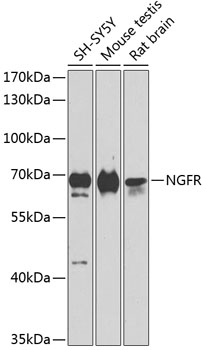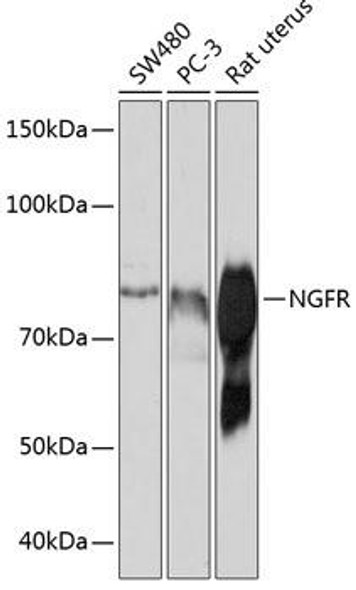Anti-NGFR Antibody (CAB11169)
- SKU:
- CAB11169
- Product type:
- Antibody
- Reactivity:
- Human
- Mouse
- Rat
- Host Species:
- Rabbit
- Isotype:
- IgG
- Antibody Type:
- Polyclonal Antibody
- Research Area:
- Cell Death
Description
| Antibody Name: | Anti-NGFR Antibody |
| Antibody SKU: | CAB11169 |
| Antibody Size: | 20uL, 50uL, 100uL |
| Application: | WB IF |
| Reactivity: | Human, Mouse, Rat |
| Host Species: | Rabbit |
| Immunogen: | Recombinant fusion protein containing a sequence corresponding to amino acids 273-427 of human NGFR (NP_002498.1). |
| Application: | WB IF |
| Recommended Dilution: | WB 1:500 - 1:2000 IF 1:50 - 1:200 |
| Reactivity: | Human, Mouse, Rat |
| Positive Samples: | SH-SY5Y, Mouse testis, Rat brain |
| Immunogen: | Recombinant fusion protein containing a sequence corresponding to amino acids 273-427 of human NGFR (NP_002498.1). |
| Purification Method: | Affinity purification |
| Storage Buffer: | Store at -20°C. Avoid freeze / thaw cycles. Buffer: PBS with 0.02% sodium azide, 50% glycerol, pH7.3. |
| Isotype: | IgG |
| Sequence: | KRWN SCKQ NKQG ANSR PVNQ TPPP EGEK LHSD SGIS VDSQ SLHD QQPH TQTA SGQA LKGD GGLY SSLP PAKR EEVE KLLN GSAG DTWR HLAG ELGY QPEH IDSF THEA CPVR ALLA SWAT QDSA TLDA LLAA LRRI QRAD LVES LCSE STAT SPV |
| Gene ID: | 4804 |
| Uniprot: | P08138 |
| Cellular Location: | Membrane, Single-pass type I membrane protein |
| Calculated MW: | 35kDa/45kDa |
| Observed MW: | 70kDa |
| Synonyms: | CD271, Gp80-LNGFR, TNFRSF16, p75(NTR), p75NTR, NGFR |
| Background: | Nerve growth factor receptor contains an extracellular domain containing four 40-amino acid repeats with 6 cysteine residues at conserved positions followed by a serine/threonine-rich region, a single transmembrane domain, and a 155-amino acid cytoplasmic domain. The cysteine-rich region contains the nerve growth factor binding domain. |
| UniProt Protein Function: | NGFR: Low affinity receptor which can bind to NGF, BDNF, NT-3, and NT-4. Can mediate cell survival as well as cell death of neural cells. Homodimer; disulfide-linked. Interacts with p75NTR- associated cell death executor. Interacts with TRAF2, TRAF4, TRAF6, PTPN13 and RANBP9. Interacts through TRAF6 with SQSTM1 which bridges NGFR to NTRK1. Interacts with BEX1 and NGFRAP1/BEX3. Interacts with KIDINS220 and NTRK1. Can form a ternary complex with NTRK1 and KIDINS220 and this complex is affected by the expression levels of KIDINS220. An increase in KIDINS220 expression leads to a decreased association of NGFR and NTRK1. Interacts with NTRK2; may regulate the ligand specificity of the NTRK2 receptor. Interacts with LINGO1. |
| UniProt Protein Details: | Protein type:Receptor, misc.; Membrane protein, integral Chromosomal Location of Human Ortholog: 17q21-q22 Cellular Component: cell surface; clathrin-coated endocytic vesicle; cytosol; endosome; external side of plasma membrane; extracellular region; Golgi apparatus; integral to plasma membrane; lipid raft; neuron projection; nuclear envelope; nucleoplasm; nucleus; perikaryon; plasma membrane; rough endoplasmic reticulum Molecular Function:beta-amyloid binding; nerve growth factor binding; neurotrophin TRKA receptor binding; protein binding; Rab GTPase binding; receptor activity; signal transducer activity; transmembrane receptor activity; tumor necrosis factor receptor activity; ubiquitin protein ligase binding Biological Process: axon guidance; central nervous system development; circadian regulation of gene expression; detection of temperature stimulus; glucose homeostasis; hair follicle morphogenesis; immune response; inflammatory response; intracellular protein transport; membrane protein intracellular domain proteolysis; negative regulation of apoptosis; negative regulation of axonogenesis; negative regulation of cell cycle; negative regulation of fibroblast growth factor receptor signaling pathway; negative regulation of hair follicle development; negative regulation of mitochondrial depolarization; negative regulation of neuron apoptosis; nerve development; nerve growth factor receptor signaling pathway; positive regulation of apoptosis; positive regulation of axonogenesis; positive regulation of fibroblast proliferation; positive regulation of MAPKKK cascade; positive regulation of myelination; positive regulation of odontogenesis of dentine-containing teeth; positive regulation of protein kinase B signaling cascade; positive regulation of Rho protein signal transduction; positive regulation of synaptic transmission, cholinergic; positive regulation of synaptic transmission, glutamatergic; regulation of apoptosis; regulation of axonogenesis; regulation of caspase activity; regulation of cell proliferation; response to lipopolysaccharide; response to wounding; sensory perception of pain; tumor necrosis factor-mediated signaling pathway |
| NCBI Summary: | Nerve growth factor receptor contains an extracellular domain containing four 40-amino acid repeats with 6 cysteine residues at conserved positions followed by a serine/threonine-rich region, a single transmembrane domain, and a 155-amino acid cytoplasmic domain. The cysteine-rich region contains the nerve growth factor binding domain. [provided by RefSeq, Jul 2008] |
| UniProt Code: | P08138 |
| NCBI GenInfo Identifier: | 128156 |
| NCBI Gene ID: | 4804 |
| NCBI Accession: | P08138.1 |
| UniProt Secondary Accession: | P08138,B2R961, B4E096, |
| UniProt Related Accession: | P08138 |
| Molecular Weight: | 35,767 Da |
| NCBI Full Name: | Tumor necrosis factor receptor superfamily member 16 |
| NCBI Synonym Full Names: | nerve growth factor receptor |
| NCBI Official Symbol: | NGFR |
| NCBI Official Synonym Symbols: | CD271; p75NTR; TNFRSF16; p75(NTR); Gp80-LNGFR |
| NCBI Protein Information: | tumor necrosis factor receptor superfamily member 16 |
| UniProt Protein Name: | Tumor necrosis factor receptor superfamily member 16 |
| UniProt Synonym Protein Names: | Gp80-LNGFR; Low affinity neurotrophin receptor p75NTR; Low-affinity nerve growth factor receptor; NGF receptor; p75 ICD; CD_antigen: CD271 |
| Protein Family: | Tumor necrosis factor receptor superfamily |
| UniProt Gene Name: | NGFR |
| UniProt Entry Name: | TNR16_HUMAN |




